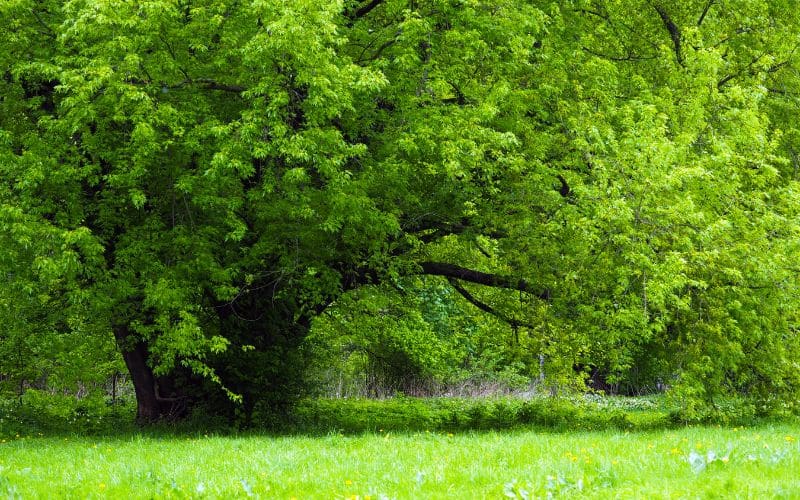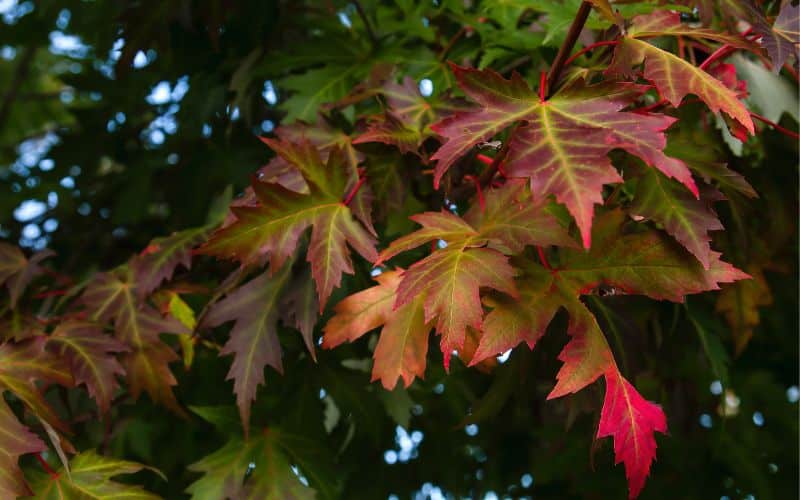
Famed for its distinctive shape and vibrant colours, the Silver Maple tree is a sight to behold in Ontario’s diverse landscapes. It’s not just an aesthetic delight; this hardy species plays a crucial role in the ecosystem, providing habitats for wildlife and improving air quality. The Silver Maple tree, also known as Acer Saccharinum, stands out with its unique features that are deeply embedded within Ontario’s natural heritage.
Your garden may be the perfect home for this magnificent specimen. Boasting a rapid growth rate and adaptability to various soil conditions, you’ll find it relatively easy to cultivate. With minimal effort on your part – some watering here, a bit of pruning there – you could have your very own Silver Maple gracing your backyard with its year-round beauty.
If you’re passionate about local flora or simply want to add more greenery into your life then consider embracing one of Ontario’s finest – the Silver Maple Tree! This introduction aims at giving you insight into what makes these trees so special and why they’re an essential part of our environment.
Understanding the Silver Maple Tree
The silver maple tree, native to Ontario, is a sight you’re likely familiar with. It’s known for its distinctive leaves, that shine silver in the wind and make a spectacular display come autumn. These trees are hardy and adaptable, making them an ideal choice for urban landscaping.
Why is it so beloved? Well, one of its key features lies in its robustness. The silver maple can grow up to 35 metres tall – that’s nearly as high as a ten-storey building! Furthermore, this species thrives in different soil types which makes it versatile enough to flourish across diverse landscapes.
Take note though – not everything about these beauties is perfect. They have their drawbacks too:
- Their branches can be brittle; hence they might pose a risk during storms.
- The roots tend to surface above ground level if planted on shallow soils or hard surfaces.
Let’s delve deeper into their lifecycle next. In springtime – usually March – your attention will be caught by clusters of small red flowers blooming on bare branches before the leaves appear; these are actually seeds preparing themselves for dispersal! After pollination by bees and other insects (yes indeed! Silver maples support local wildlife), seed pods develop which helicopters down when matured around late spring or early summer time.
Talking about numbers:
| Life Span | Growth Rate |
|---|---|
| Upwards of 130 years | Fast-growing at around 30-60 cm per year |
These stats give us some perspective about how quickly these trees mature compared with other species!
Distinguishing Features of Ontario’s Silver Maple
Ontario’s silver maple tree, a true jewel in Canada’s natural crown, holds some truly distinctive features. This native Canadian tree is not only stunning to look at but also plays an essential role in our ecosystem.
Known for its fast growth and impressive size, the silver maple often reaches heights of 15-25 metres with some mature trees soaring up to 35 metres tall. That’s nearly as high as Niagara Falls! But it isn’t just about height; these trees also have a significant spread – their branches can reach out anywhere between 12-18 metres across.
The trunk of the silver maple is another defining feature you’ll notice. It has this greyish bark that tends to crack into long plates as it matures – giving each tree a unique pattern and character.
And let’s not forget those iconic leaves! They’re the real show-stoppers when it comes to identifying this species from others within its family. Characterised by five deeply cut lobes and sharp-pointed teeth around the edges, they display an unusual silvery-white underside which gives rise to the name ‘silver’ maple.
To add even more charm during autumn months, these leaves turn into magnificent shades ranging from bright yellow through orange-red hues – making Ontario landscapes come alive with colour!
Last but certainly not least are those lovely winged seeds or ‘samaras’. Unlike many other types of maples whose samaras hang downwards like little helicopters ready for take-off, on a silver maple they angle upwards towards the sky – creating quite a spectacle during springtime dispersal!
So next time you’re out exploring nature in Ontario keep your eyes peeled for these distinctive characteristics:
- Fast-growing large trees reaching up to 35m
- Wide branch spread between 12-18m
- Grey bark that cracks into long plates
- Five lobe leaves with silvery undersides
- Colourful autumn foliage
- Upward-angled winged seeds
Growth and Care for Your Silver Maple in Ontario
Caring for your silver maple tree, it’s not as daunting as you might think. In fact, with a bit of knowledge and some regular attention, you can keep your tree healthy and thriving. Native to the eastern United States but widely grown in Ontario too, this species is valued for its rapid growth rate and beautiful silvery leaves.
The first thing you need to know about growing a silver maple is that it loves sunlight. These trees do best in full sun conditions – at least six hours of direct sunlight each day will ensure optimal growth. So if you’re thinking about where to plant one on your property, make sure it won’t be overshadowed by buildings or other larger trees.
Watering requirements are another key aspect of caring for your silver maple. While these trees are drought-tolerant once established, they prefer consistently moist soil during their initial growth period. Be mindful not to overwater though; soggy soil can lead to root rot which could seriously damage or even kill the tree.
Pruning is essential too when maintaining the health and shape of any tree – but especially so with fast-growing varieties like the silver maple which tend towards becoming ‘leggy’. It’s best done during late winter or early spring before new leaf buds begin forming – just remember always remove dead wood first then focus on shaping branches afterwards.
And let’s not forget fertilising! A balanced slow-release fertilizer applied annually should provide all necessary nutrients needed by a developing young Silver Maple. Remember:
- Full Sunlight
- Consistent watering without waterlogging
- Annual pruning
- Balanced Fertilizer
With these tips under your belt there’ll be no stopping you from nurturing an impressive specimen that stands tall amongst its peers!
The Ecological Impact of the Silver Maple in Ontario
You might be surprised to learn that the humble Silver Maple tree has a significant ecological impact in Ontario. Known for its distinctive silver-grey bark and vibrant autumn foliage, this native Canadian species plays a crucial role within local ecosystems.
Firstly, let’s consider how these trees contribute to biodiversity. In fact, they’re an important source of food and shelter for various wildlife species. Birds such as finches feast on their seeds while squirrels often make nests amongst their branches.
| Wildlife Species | Use |
|---|---|
| Finches | Feed on seeds |
| Squirrels | Nesting |
Secondly, think about the role they play in soil health. The fallen leaves from Silver Maples decompose into organic matter that enriches soil fertility. This process is essential for maintaining healthy plant communities throughout Ontario.
Additionally, it’s worth noting these trees’ ability to improve air quality. Through photosynthesis – where plants convert carbon dioxide into oxygen – Silver Maples help cleanse our atmosphere each day.
To illustrate this point further:
- One mature tree can absorb around 22 kilograms of CO2 per year
- That equates roughly to offsetting 80 kilometres driven by an average passenger vehicle
Lastly but no less importantly is flood control; you see with strong root systems like those found on the Silver Maple, excess rainwater gets absorbed which helps prevent flooding and erosion particularly along river banks.

Conclusion: The Importance of the Silver Maple to Ontario
Without a doubt, you’ll come to appreciate the significance of the Silver Maple tree in Ontario. This native gem contributes profoundly to both ecological and economic aspects of life.
From an ecological standpoint, it’s impossible not to recognise its importance. You see, these trees serve as vital habitats for various wildlife species. Birds build their nests high up in their sturdy branches while insects find shelter within its bark.
The table below highlights some key statistics:
| Wildlife Species | Dependence on Silver Maples |
|---|---|
| Birds | High |
| Insects | Moderate |
Moving onto another aspect – economics – you might be intrigued by how this tree contributes significantly towards boosting local economies. It’s not just about timber production; think maple syrup too! That sweet condiment that Canadians love is primarily sourced from our beloved silver maples.
Let’s take a look at some numbers here:
- Timber Production: Contributes approximately $20 billion annually
- Maple Syrup Industry: Worth around $180 million per year
What’s more? These trees also play a pivotal role when it comes down to climate change mitigation. They’re excellent carbon sinks which means they absorb large amounts of CO2 from our atmosphere thereby reducing greenhouse gas emissions.
So there you have it! Your understanding should now encompass why we value these magnificent trees so much here in Ontario. From being home for wildlife, bolstering local economy and combatting climate change – the silver maple truly stands tall amongst all other species.









